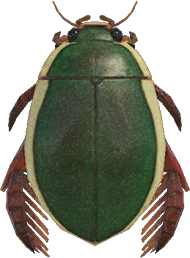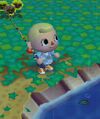Diving beetle
- "I caught a diving beetle! I give it a perfect 10!" —City Folk
- "I caught a diving beetle! It's like I have sonar or something!" —New Leaf
The Diving Beetle (ゲンゴロウ, Gengorō), also known as the Water Beetle in Doubutsu no Mori e+, is a common insect found in rivers and ponds, swimming and diving. They are worth 800 Bells. It appears during the months of May through September, and was introduced in Doubutsu no Mori e+. It is common to find when it is raining, but can be caught in all weather. The Diving Beetle is found underwater, with a dark shadow like fish, and above water, showing their green bodies. To catch them, they need to be above the water. When caught, the "Bugs and Fish" window says "These are said to have short but strong pincers. Ouch!".
Catch details
In New Leaf
| Time of year | May - Sep |
|---|---|
| Time of day | 8 AM - 5 PM |
| Peak times | N/A |
| Location | On rivers and ponds |
| Size | 38 mm |
| Rarity | Uncommon |
| Selling price | |
| Furniture size |
In New Horizons
| Time of year | North: May – Sep South: Nov – Mar |
|---|---|
| Time of day | 8 AM – 7 PM |
| Location | On rivers and ponds |
| Weather | Any weather |
| Spawn requirement | Appears from the start of the game |
| Selling prices | |
| Furniture size |
Donating to the museum
In City Folk
If the player donates the Diving Beetle to the museum, Blathers will make a comment on it.
"While they're marginally less odious as adults...dive beetles are horrific in their larval stage! These wretched youths are twice the size of the adults and wield a large poison barb. Foul villainy! Then again, I suppose the adults aren't much better. They're both completely objectionable, really..."
It can be found in the bottom-left hand enclosure in the insect exhibition, in the small pond.
In New Leaf
Upon being donated, the beetle can be found in the first room of the bug exhibit swimming in the pond just outside the butterfly house.
"Diving beetles swim using thick, hairy hind legs and clean the water by eating dead insects. They store a supply of air under their wings to breathe underwater and surface to replenish as needed. When they're caught by predators, they release a foul-smelling bluish fluid from their heads in defense."
In New Horizons
"Ah, the dastardly diving beetle! Famous for its distinctive round shape...and its voracious appetite. This powerful predator uses thick back legs covered in hairs to paddle after its prey. And it uses suction cups on its front legs to grip its quarry for good. My own legs have gone weak thinking about it..."
When donated, the diving beetle can be found swimming in the southwestern water tank of the bug exhibit. It shares this habitat with the pondskater, Giant Water Bug, and some donated fish.
Real-world information
Adult beetles have streamlined, oval, or football-shaped flattened bodies that are usually 12-25 millimeters (1/8-1 inch) long. Most species are brown to black but some have distinctive patterns of spots, lines, or mottling on the wing covers. They have elongate hairlike antennae. Larvae are not frequently seen and have a long thorax and long legs. The head bears conspicuous large sickle-shaped mandibles without teeth.
Predaceous diving beetles are easily confused with water scavenger beetles (Coleoptera: Hydrophilidae). The latter surface for air head first and have a ridge or keel on the underside that runs down the thorax and extends into a point.
Names in other languages
| ゲンゴロウ gengorō |
Diving beetle (etymology unknown) | |
| 물방개 mulbanggae |
Diving beetle | |
| 龙虱 lóngshī |
Diving beetle (lit. "dragon louse") | |
| 龍蝨 Unknown |
||
| Плавунец Plavunets |
Diving beetle | |
| Waterroofkever | "Water predator Beetle" | |
| Schwimmkäfer | "Swimming beetle" | |
| Escarabajo Nadador | "Swimming beetle" | |
| Dytique | From family name Dysticidae | |
| Ditisco | From family name Dysticidae | |
| Bugs | |||||||||||||||||||
|---|---|---|---|---|---|---|---|---|---|---|---|---|---|---|---|---|---|---|---|
| |||||||||||||||||||

